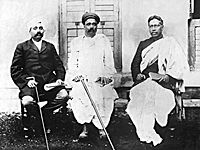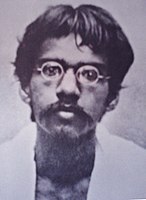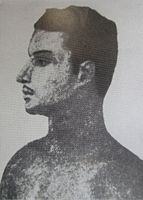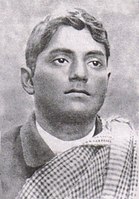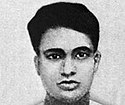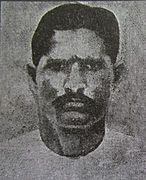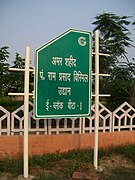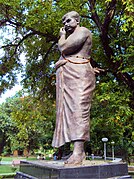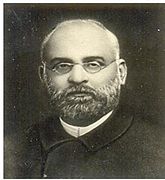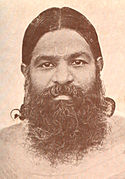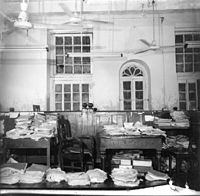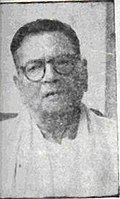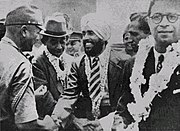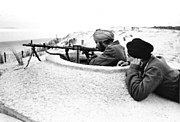
The Indian Independence Movement, was a series of historic events in South Asia with the ultimate aim of ending British colonial rule. It lasted until 1947, when the Indian Independence Act 1947 was passed.
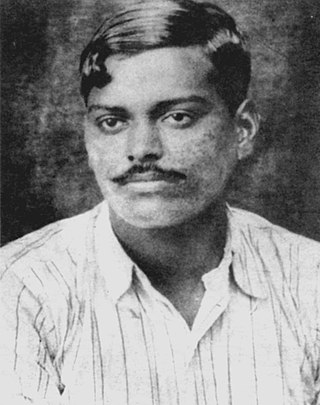
Chandra Shekhar Sitaram Tiwari, popularly known as Chandra Shekhar Azad, was an Indian revolutionary who reorganised the Hindustan Republican Association (HRA) under its new name of Hindustan Socialist Republican Association (HSRA) after the death of its founder, Ram Prasad Bismil, and three other prominent party leaders, Roshan Singh, Rajendra Nath Lahiri and Ashfaqulla Khan. He hailed from Bardarka village in Unnao district of United Provinces and his parents were Sitaram Tiwari and Jagrani Devi. He often used the pseudonym "Balraj" while signing pamphlets issued as the commander-in-chief of the HSRA.
Emperor v Aurobindo Ghosh and others, colloquially referred to as the Alipore Bomb Case, the Muraripukur conspiracy, or the Manicktolla bomb conspiracy, was a criminal case held in India in 1908. The case saw the trial of a number of Indian nationalists of the Anushilan Samiti in Calcutta, under charges of "Waging war against the Government" of the British Raj. The trial was held at Alipore Sessions Court, Calcutta, between May 1908 and May 1909. The trial followed in the wake of the attempt on the life of Presidency Magistrate Douglas Kingsford in Muzaffarpur by Bengali nationalists Khudiram Bose and Prafulla Chaki in April 1908, which was recognised by the Bengal police as linked to attacks against the Raj in the preceding years, including attempts to derail the train carrying Lieutenant-Governor Sir Andrew Fraser in December 1907.
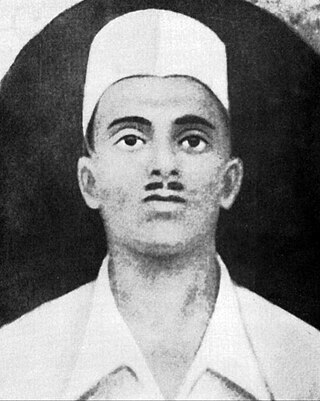
Sukhdev Thapar was an Indian freedom fighter who fought against the British government for the freedom of India. He was a member of the Hindustan Socialist Republican Association (HSRA). He was executed along with Shivaram Rajguru and Bhagat Singh on 23 March 1931.

Ram Prasad Bismil was an Indian poet, writer, revolutionary and an Indian freedom fighter who participated in the Mainpuri Conspiracy of 1918, and the Kakori Conspiracy of 1925, and fought against British Raj British Imperialism. He also had a good command over Urdu and the Hindi languages and was an accomplished poet, composing in these languages using the pen names Ram - राम , Agyat and Bismil A person who has been killed - बिस्मिल, the latter through which he became famously known by.

Anushilan Samiti was an Indian fitness club, which was actually used as an underground society for anti-British revolutionaries. In the first quarter of the 20th century it supported revolutionary violence as the means for ending British rule in India. The organisation arose from a conglomeration of local youth groups and gyms (akhara) in Bengal in 1902. It had two prominent, somewhat independent, arms in East and West Bengal, Dhaka Anushilan Samiti, and the Jugantar group.
Jugantar or Yugantar was one of the two main secret revolutionary trends operating in Bengal for Indian independence. This association, like Anushilan Samiti, started in the guise of a suburban health and fitness club while secretly nurturing revolutionaries. Several Jugantar members were arrested, hanged, or deported for life to the Cellular Jail in Andaman and many of them joined the Communist Consolidation in the Cellular Jail.
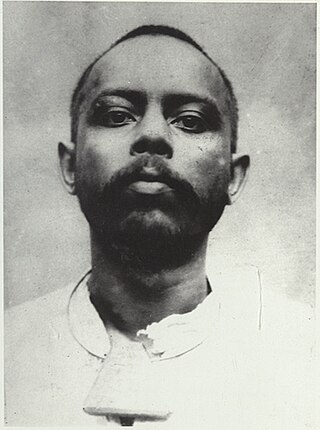
Ullaskar Dutta was an Indian revolutionary associated with Anushilan Samiti and Jugantar of Bengal, and was a close associate of Barindra Ghosh. He was the principal bomb maker of the Jugantar group until Hemchandra Kanungo returned from Paris learning political theory and explosive chemistry.
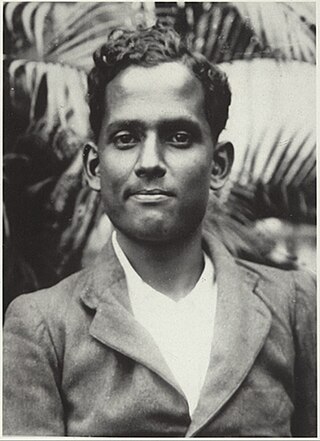
Jatindra Nath Das, better known as Jatin Das, was an Indian independence activist and revolutionary who worked to make India independent from the British Raj and was a member of the Hindustan Socialist Republican Association. He died in the Lahore Central Jail after a 63-day hunger strike.
Hindustan Socialist Republican Association (HSRA), previously known as the Hindustan Republican Army and Hindustan Republican Association (HRA), was a radical left-wing Indian revolutionary organisation were founded by Sachindranath Sanyal - Shanyal Babu and later on it other joined. After changes of Shaheed-E Aazam Bhagat Singh's new ideology and the influence of the Russian Revolution, they held meetings in Feroz Shah Kotla Maidan and added the word socialist to their name. Ram Prasad Bismil, Ashfaqulla Khan, Sachindra Nath Bakshi, Sachindranath Sanyal and Jogesh Chandra Chatterjee were then leaders. HRA's manifesto titled The Revolutionary and written constitution were produced as evidence in the Kakori conspiracy case of 1925.

Jadu Gopal Mukherjee was a Bengali Indian revolutionary who, as the successor of Jatindranath Mukherjee or Bagha Jatin, led the Jugantar members to recognise and accept Gandhi's movement as the culmination of their own aspiration.

Batukeshwar Dutt was an Indian socialist and independence fighter in the early 1900s. He is best known for having exploded two bombs, along with Bhagat Singh, in the Central Legislative Assembly in New Delhi on 8 April 1929. After they were arrested, tried and imprisoned for life, he and Singh initiated a historic hunger strike protesting against the abusive treatment of Indian political prisoners, and eventually secured some rights for them. He was also a member of the Hindustan Socialist Republican Association.
Communist Consolidation was an Indian revolutionary and communist organization, founded by Hare Krishna Konar among with other prisoners of the Cellular Jail with the ideology of Marx and Lenin's theory Marxism–Leninism. It was the largest resistance group against British rule in the Jail, this organization also led the historical 36-days hunger strike in 1937 where the British government had to bow before the demands of the political prisoners.

The Kakori Train robbery was a train robbery that took place at Kakori, a village near Lucknow, on 9 August 1925, during the Indian independence movement against the British rule in India. It was organized by the Indian revolutionaries of Hindustan Republican Association (HRA).
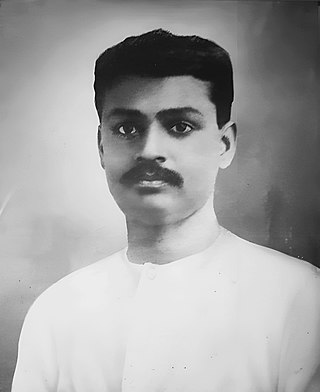
Sachindra Nath Sanyal was an Indian revolutionary and co-founder of the Hindustan Republican Association that was created to carry out armed resistance against the British Empire in India. He was a mentor for revolutionaries like Chandra Shekhar Azad, Jatindra Nath Das, and Bhagat Singh.
The first Christmas Day plot was a conspiracy made by the Indian revolutionary movement in 1909: during the year-ending holidays, the Governor of Bengal organised at his residence a ball in the presence of the Viceroy, the Commander-in-Chief and all the high-ranking officers and officials of the Capital (Calcutta). The 10th Jat Regiment was in charge of the security. Indoctrinated by Jatindranath Mukherjee, its soldiers decided to blow up the ballroom and take advantage of destroying the colonial Government. In keeping with his predecessor Otto von Klemm, a friend of Lokmanya Tilak, on 6 February 1910, M. Arsenyev, the Russian Consul-General, wrote to St Petersburg that it had been intended to "arouse in the country a general perturbation of minds and, thereby, afford the revolutionaries an opportunity to take the power in their hands." According to R. C. Majumdar, "The police had suspected nothing and it is hard to say what the outcome would have been had the soldiers not been betrayed by one of their comrades who informed the authorities about the impending coup".
The history of the Anushilan Samiti stretches from its beginning in 1902 to 1930. The Samiti began in the first decade of the 20th century in Calcutta as conglomeration of local youth groups and gyms(Akhra). However, its focus was both physical education and proposed moral development of its members. From its inception it sought to promote what it perceived as Indian values and to focus on Indian sports e.g. Lathi and Sword play. It also encouraged its members to study Indian history as well as those of European liberalism including the French Revolution, Russian Nihilism and Italian unification. Soon after its inception it became a radical organisation that sought to end British Raj in India through revolutionary violence. After World War I, it declined steadily as its members identified closely with leftist ideologies and with the Indian National Congress. It briefly rose to prominence in the late second and third decade, being involved in some notable incidents in Calcutta, Chittagong and in the United Provinces. The samiti dissolved into the Revolutionary Socialist Party in 1930.

Shiv Verma was an Indian Marxist revolutionary and a member of the Hindustan Socialist Republican Association.

Bejoy Kumar Sinha was an Indian revolutionary and member of Hindustan Socialist Republican Association.
Communists were actively involved in Indian independence movement through multiple series of protests, strikes and other activities. It was a part of revolutionary movement for Indian independence. Their main thrust was on organising peasants and working classes across India against the British and Indian capitalists and landlords.

